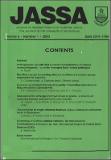| dc.contributor.author | Chibatamoto, P.P. | |
| dc.contributor.author | Charimari, L.S. | |
| dc.contributor.author | Chando, E.C. | |
| dc.coverage.spatial | Zimbabwe. | en |
| dc.date.accessioned | 2016-02-29T09:06:38Z | |
| dc.date.available | 2016-02-29T09:06:38Z | |
| dc.date.issued | 2000 | |
| dc.identifier.citation | Chibatamoto, P. P., Charimari, L.S. and Chando, E.C. (2000) A survey on contact tracing of sexually transmitted infections in Mazowe District (Zimbabwe), Journal of Applied Science in Southern Africa (JASSA), vol. 6, no. 1, pp. 25-37. Harare: UZ Publications. | en |
| dc.identifier.issn | 1019-7788 | |
| dc.identifier.uri | https://opendocs.ids.ac.uk/opendocs/handle/20.500.12413/9596 | |
| dc.description | A research article on the high incidence of Sexually Transmitted Infections (STI's) in the face of the HIV/AIDS scourge in Zimbabwe. | en |
| dc.description.abstract | A total of 632 sexually transmitted infected index patients and 168 sexual partners (156 partner referral and 12 provider referral) were seen at ten health centres of Chiweshe Communal Area, Mashonaland Central Province between September 1998 and March 1999. All STI index patients who visited the study sites were observed, counselled and treated by the nurses. A questionnaire to determine the reproductive/ sexual behaviour of patients and their partners was administered to the index patient. Of the 632 index patients observed, almost half (46 percent) presented with vaginal discharge syndrome, 26 percent with genital ulcer disease and 16 percent with urethral discharge syndrome.
Out of a total of 168 partners referred to the health centres, 93 percent had been referred by index patients and only 7 percent by health workers. The majority (61 percent) of the index patients were female. On average, the index patients were 30.03 + 9.97 years old. The majority of the clients (56 percent index patients and 70 percent contacts) were married (monogamous). About a third of all the clients had completed form four (Ordinary Level) and were highly knowledgeable of STIs - particularly genital ulcers and urethral discharge syndrome. Friends and relatives were reported to be the first source of information on STIs.
About half the index patients reported that they never use condoms and yet they felt they were at high risk of contracting STIs because their partners were not faithful. This survey established that people’s behaviour has not been significantly changed by the AIDS pandemic.
There is urgent need to find out why condom use is low, even when people do feel to be at risk. | en |
| dc.language.iso | en | en |
| dc.publisher | University of Zimbabwe (UZ) Publications | en |
| dc.rights.uri | http://creativecommons.org/licenses/by-nc-nd/3.0/ | en |
| dc.subject | Health | en |
| dc.subject | Sexuality and Development | en |
| dc.title | A survey on contact tracing of sexually transmitted infections in Mazowe District (Zimbabwe) | en |
| dc.type | Article | en |
| dc.rights.holder | University of Zimbabwe (UZ) | en |


